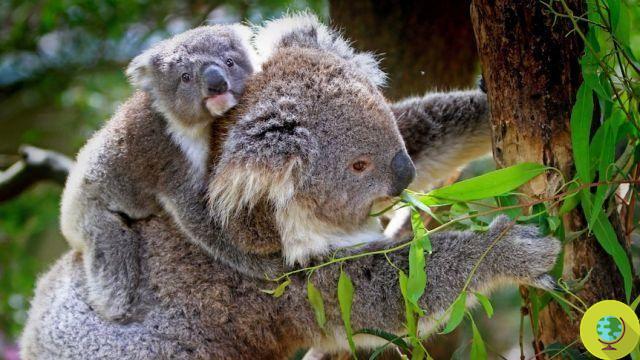
How does the koala survive by eating leaves that are toxic to almost all animals? And how to avoid its extinction given that it feeds only on eucalyptus leaves, a tree that is gradually disappearing due to deforestation? To these and other questions about one of the animals that arouse the sweetest of all, its genes will be able to answer directly. In fact, the koala genome has been mapped for the first time with the aim of seeking new solutions to protect its drastically reduced population, also due to the disappearance of its main food, eucalyptus leaves.
How does the koala survive by eating leaves that are toxic to almost all animals? And how to avoid its extinction given that it feeds only on eucalyptus leaves, a tree that is gradually disappearing due to deforestation? To these and other questions about one of the animals that arouse the sweetest of all, its genes will be able to answer directly. In fact, the koala genome has been mapped for the first time with the aim of seeking new solutions to protect its drastically reduced population, also due to the disappearance of its main food, eucalyptus leaves.
More than 50 scientists have succeeded in discovering the information of over 26 thousand genes, capable of improving the strategies for the survival of the sweet marsupial and treating the diseases that affect it, starting with chlamydia.
With its adorable face, the koala is one of Australia's most iconic animals, but how to avoid its extinction, also considering its diet which is based only on eucalyptus leaves, a tree also on the verge of massive disappearance ?
The mapping of the genome of this tender animal contained in a new study published in Nature Genetics will certainly provide several answers. A sequencing done for the first time by the Koala Genome Consortium and a team of scholars led by Rebecca Johnson of the Research Institute of the Australian Museum and Katherine Belov of the University of Sydney.
The koala DNA sequencing project started in 2013 and is attended by 54 scientists from 29 institutions in 7 different countries. The researchers analyzed more than 3,4 billion base pairs and nearly 30 genes, which make the koala's genome slightly larger than that of humans.
Peering into the koala's genes first offered researchers insight into how he survives on his (toxic) diet of eucalyptus and will help them understand how to save this endangered puppy.
Koalas are found in the forests of eastern and southeastern Australia, as well as some islands. But the Australian icon "bear", which some do not hesitate to call a "national treasure", is a victim of habitat destruction, climate change, unscrupulous car drivers and sexually transmitted diseases.
When the first British settlers arrived in 1788, koalas numbered over ten million. Today, according to the Australian Koala Foundation, they are just over 43 in the wild, so much so that this marsupial is listed as “vulnerable” on the IUCN Red List of the International Union for Conservation of Nature (IUCN).
A systematic review
More than 50 researchers collaborated on this project by discovering 26.558 genes and deciphering the marsupial genome with 95,1% accuracy, which is comparable to what was achieved with the human genome. A first analysis that allows us to know a little more about the unique biology of this animal, endemic to Australia, and in particular that "excellent instrumentation" which is that genetic complex that allows it to digest eucalyptus leaves, containing phenols (carbolic or phenyl acid) toxic to animals.
The koala in fact easily devours a kilo of eucalyptus leaves a day (even if it sleeps 20 hours a day) and this “probably helped it find a niche of food thanks to which to survive. He can count on this food source with almost no competition, since other species cannot detox as effectively, ”Rebecca Johnson points out.
But this particularity that can be considered an advantage has its counterpart: this almost exclusive diet makes it particularly vulnerable to the disappearance of the eucalyptus forests themselves, both due to the intensification of deforestation and urban development.
Vaccinate the koalas?
The researchers also identified genes linked to their immune systems, taking a step towards the development of vaccines to combat certain diseases, such as chlamydia (asymptomatic bacterial infection) that devastates koala populations, especially in New South Wales and Queensland. There is currently no treatment for this sexually transmitted disease, which can lead to blindness, infertility and death.
Furthermore, human development invades the koala's territory forcing them to live closer and closer to each other, which increases the interaction between individuals and the risk of contamination. Koalas found in South Australia, in that regard, have a high inbreeding rate, but a large population. This situation is very different from that faced by those in the north, where "they are constantly losing habitat or building roads, but they are very different genetically".
Looking at them through the lens of genomics offers new possibilities for conservation, so, according to scholars, if genetic diversity in the south becomes low enough and cannot be resolved in other ways, for example, it may be possible to introduce genetic diversity using koalas. from the north.
On the basis of the information obtained from the koala genome, in short, it is now hoped to save one of the most beautiful endemic species on the planet.
Read also
- The koala mutilated and brutally killed
- Plant hundreds of trees to save koalas' lives (PHOTO)
- Koala at risk of extinction. More trees are needed
Germana Carillo
Koalas: this is how they manage to survive their "toxic" diet


























